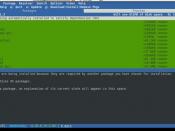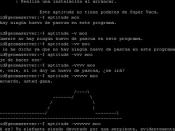When measuring people's performance for the purpose of selection there are a number of key issues involved. The first section of this essay will explain these issues before explaining how they can be overcome in the second section. The final part of this essay will deal with the advantages and disadvantages of using the interview method as a selection tool, before concluding the main points.
Human resource selection is a process that requires the measurement of candidates to enable accurate decision making in making an appointment. The goal of the selection system is to select individuals who will perform well on the job. The system must be as fair and accurate as possible and must use reliable and valid measures of job applicant characteristics.
One issue in measuring performance for selection purposes is the reliability of the tests used to measure the individuals. The term reliability refers to the consistency of the selection and assessment process in giving the same results and this can be with similar sets of people or with the same people over a period of time.
If the tests used are unreliable then the sample will contain systematic and random errors. A test score is consistent (and therefore reliable) if random error is low and there are minimal fluctuations in observed scores. The ideal situation is for the test scores to be free from systematic and random error. There are three main methods of assessing reliability each using the correlation coefficient as the index of reliability with 0.8 or higher being considered good. The three methods are:
* Test-retest - This method examines the consistency of a selection tool over time. The correlation is computed between the time 1 score and the time 2 score. This correlation is called the coefficient of stability.
* Parallel forms - This method of assessing reliability is appropriate when two versions of the same selection tool are used. The correlation between scores for form A and form B of the test. The correlation is called the coefficient of equivalence. When two different interviewers interview the job applicant and each rate them separately on a number of dimensions, the interviews can be viewed as parallel forms of the same interview test. The correlation between the two evaluations is known as inter-rater reliability.
* Internal consistency - This method is similar to the parallel form method except that individual items on a selection tool, rather than the whole tool is assessed for their equivalence to each other. This type of reliability helps to assess whether all the items on a test are testing for the same trait or ability that is whether they are internally consistent.
(Fischer, Schoenfeldt and Shaw, 1990)
Each method of assessing reliability provides different information about the types of error that may affect a particular type of test. To cover all possible sources of error the use of multiple methods may be necessary. Reliability serves as the foundation upon which the validity of a test can be established. If a test cannot measure people consistently then it cannot be valid.
The next issue in measuring performance for selection purposes is about ensuring the validity of the measuring instruments used. A measuring instrument can be considered valid if it does what it is supposed to do. In this case the measuring instruments are intended to:
* Exhibit a predictive relationship with an important variable such as job performance.
* Represent a specific job performance domain that is including a representative sampling of the types of work employees have to do in the performance of their jobs.
* Measure a specific psychological, personality or ability characteristic of an individual.
The above represent three types of validity: criterion-related validity, content validity and construct validity. (Fischer, Schoenfeldt and Shaw, 1990)
In a criterion-related study the job is first analysed. Tests are chosen which are intended to predict job performance. One method of determining criterion-related validity is through predictive validity, which is concerned with how an individual will actually perform in the job. The chart in the appendix entitled the variations in the predictive validity of selection methods shows how valid the selection methods are in predicting how the person will perform in the job. When viewing the chart it is important to remember that a correlation coefficient of 0.8 is considered to be a good prediction and that none of the tools of selection can individually reach this and so there is a need to use a variety of methods. In order to establish the predictive validity of a selection tool an applicant's test scores from the selection tool are recorded and correlated with the scores gathered from performance tests taken at a later date. This correlation indicates the link between performance in pre-appointment selection activities and post-appointment performance.
Content validity is concerned with whether or not a test is representative of the type of work an employee will have to do in the performance of the job. For example it is impossible to assess an individuals ability to work as a member of a team in an interview, but this is more easily done in a "leaderless group" activity as part of an assessment centre. The content validity enables a ratio to be calculated that gives the validity of each selection tool in terms of the performance of the job.
Construct Validity deals with what abilities, aptitudes, behaviours or other personality traits the selection and assessment process measures and how well it measures them. There are a number of specific psychological, personality or ability characteristics that may need to be measured accurately and these are listed below: (Rodgers)
Human Attributes Required To Perform Specified Work Tasks
1. Physical Attributes and Appearance
What does the job require in the way of general health, strength, agility, appearance, manner and voice?
It may demand a minimum or maximum stature, absence of allergies, ability to work in confined spaces, pleasing appearance and manner (for contacts with the public) and absence of accent in speech.
2. General Intelligence
What level of general intelligence is required to do the job (a) satisfactorily and (b) well?
It may make no particular demand in this area beyond 'ordinary intelligence', or it may require higher levels of generalised aptitude or 'book learning', which may be measured by appropriate tests.
3. Special Aptitudes
Does the job require any special aptitudes, for example motor, manual dexterity, verbal, musical, mechanical, spatial or perceptual aptitudes?
Manual work often calls for mechanical and spatial aptitudes and office work for perceptual and verbal aptitudes, for the measurement of which special tests are available.
4. Attainments
What does the job demand by way of general education, specialised training and previous experience?
One broad approach to identifying skills and aptitudes is to look at attainments, which other successful jobholders have had, and to associate them with the kind of information to be found on the usual application form or curriculum vitae.
5. Interests
Does the job require the holder to have special interests for example outdoors pursuits, being with other people, or would performance be improved if the person had such interests?
Although for many jobs such interests might be totally irrelevant, others, such as the jobs of farm worker, supervisor, might benefit from their presence.
6. Disposition
Does the job call for special qualities such as those of leadership, reliability, sense of responsibility, self- reliance, and acceptability to others?
Personality and temperament clearly play a more important in the successful performance of some jobs than of others.
Many of the above criteria are known as 'soft' items which means that they cannot be easily change into quantifiable data and as a result are always subject to an opinion. Construct validity occurs when there is proof that a certain type of test is can be used to measure some of the above criteria. For example a personality test could obtain details of a persons interests that could be of use within the job like a love of the outdoors for a candidate wanting to be a shepherd, however is less useful for testing a receptionists ability to use the phone. When construct validity exists there must also be evidence that the characteristic is required within the job.
In order to ensure that reliability and validity are maintained in the selection process, consideration must be given to:
* Establishing the qualities that are required in the job. Job analysis.
* How to measure the job qualities for selection. Choice of Selection tools.
* Maintain consistency.
* Correct interpretation of results.
The strategic job analysis can be defined as 'specification of the tasks to be performed and the knowledge, skills and abilities required for effective performance for a job as it is predicted to exist in the future' (Schneider and Konz 1989). The "job summary proforma" in the appendix shows the categories that are used by Zurich PLC when they wish to carry out job analysis. The categories in the job summary proforma have the purpose of establishing the standards required by the job in order to perform the job well. Validity requires that the criteria that are chosen to link variables of the individual with variables of job performance truly represent the content of the job. At Zurich PLC they also use a person specification proforma as shown in the appendix so that value can be placed on to the sections that are relevant to each post. If the job analysis is not accurate then the selection that takes place will not be valid or reliable because the criteria against which the candidate was judged are incorrect.
The choice of selection tools to be used should be decided by establishing how best to test the candidates for the knowledge, skills and abilities required for the effective performance of the job. The selection tools used to measure the performance of external applicants must maintain reliability and validity in order to encourage successful selection. As already mentioned the chart 'Variations in the predictive validity of selection methods' shows that individually the various methods for predicting future performance do not offer a high predictive validity. This means that in order to improve the value a range of methods are required. A typical recruitment may involve a number of selection techniques used to decrease the number of applicants to a number that can be tested at greater expense using the more sophisticated techniques such as assessment centres. On many occasions it may be possible for the company to use internal recruitment to fill a position an under these circumstances the candidate past performance (Appraisal results, supervisor interviews etc.) record can be used to give a more accurate long term picture of their abilities. It is important to remember that all selection techniques used should be relevant to the job and be able to extract the information that is being tested for.
Maintaining consistency within the selection techniques is important in maintaining reliability and validity. The techniques used to measure the performance of the candidates should try to maintain consistency and each applicant should be tested in the same manner as the other applicants. Some of the techniques such as psychological testing will have the same content each time and a consideration should be given to maintaining an environmental consistencies such as where the test is undertaken, where as a tool such as the interview needs to be monitored for content consistency.
The correct interpretation of the results that are gathered from the performance measuring selection tools is essential in selecting a candidate able to perform the job. The results gained from the tests must be measured against the original needs of the job as specified in the job analysis in order to be sure that the candidate is able to perform. Often selection is based on selecting the best individual on offer and not on their suitability for the job.
One method of selection that is commonly used within Britain is the standard interview. The typical interview involves one or more interviewers asking the interviewee a number of questions designed to establish their suitability to the job. This method has a predictive validity correlation coefficient of between 0.1 and 0.2 (See Appendix) that means that it has little value in measuring performance successfully for the purpose of selection. The reasons for it having a low predictive validity are shown in the following weaknesses:
* Interviewee performance can vary between interviews so reliability is not guaranteed.
* Does not tell employer how employee would perform job.
* Structure can vary between interviews reducing the consistency of the interview as a selection tool and the question used may be leading.
* Interviewers may lack the listening, oral and non-verbal behaviour skills required to effectively conduct an interview.
* Interviewees are often compared against each other and not the original job specification.
* Interviewer bias such as the 'halo effect', first impressions and stereotyping may prevent the interviewer from making an objective measure of performance.
* Subjectivity of approach means that candidates can be rated differently by different interviews. (Inter-rater coefficient)
The main strengths of the interview method as a measure of performance for selection purposes are:
* An insight can be gained into the candidates personality and how they react with others.
* The candidate can view the work place and gain an indication of the work culture and environment.
* Human attributes such as appearance can be measured.
The interview method can be improved in a number of ways that will help to improve its reliability and validity. (Graham and Bennett, 1998)
1. The process could be improved through the use of:
* A structured and standardised approach.
* A foundation of full job analysis and job description.
* Applicants to interviewed by more than one interviewer. (e.g. successive interviews, panel interviews)
2. Interview decisions could be improved through the use of:
* Carefully framed and situational questions.
* Improved listening.
* Time control over sections of the interview and delay of decisions to the end.
* Assessment of each candidate immediately after the interview.
* Avoidance of stereotyping/bias.
* Awareness of the influence of non-verbal signs.
When all of the above factors are satisfied the interview can show an increase in predictive validity to 0.4 (see appendix: variations in the predictive validity of selection methods) in the case of situational interviews. This means that as a tool for measuring performance for selection purposes the interview is very difficult to use effectively as there are many factors to consider in order to maintain validity. This means that the interview is of use where the job requires the holder to have certain human attributes such as interests or special aptitudes that may be explored in an interview situation.
In conclusion in order to maintain reliability and validity when measuring performance for the purpose of selection the criteria on which the performance is measured must be accurate to the job and a variety of tools should be used that ensure the predictive, content and construct validity of the selection. The final point of the essay is that no matter what steps are taken to ensure the reliability and validity of the selection it is impossible to perfectly predict how an applicant will actually behave in the job and any selection that is made can only be an estimation.


